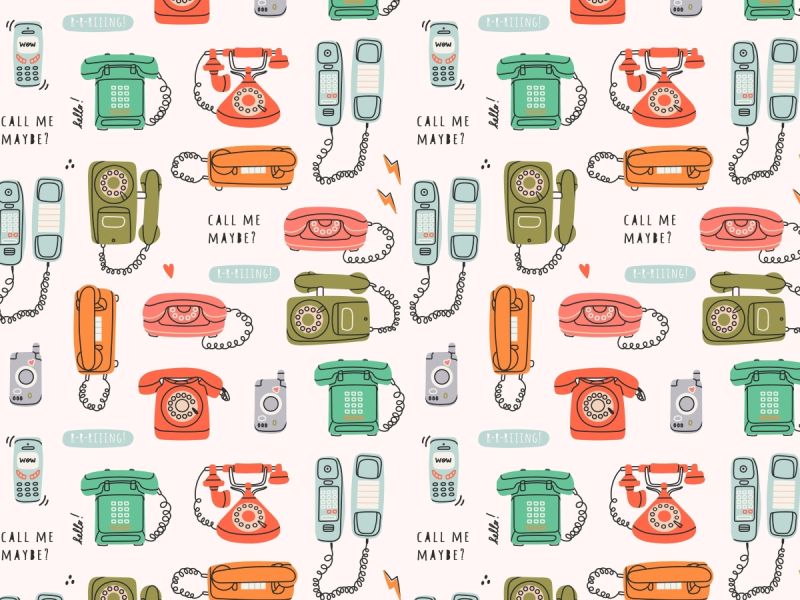Just for Fun: Give Us A Bell; Our Favourite Fascinating Facts About Phones

Alexander Graham Bell was born on 3rd March 1847. He is best known for patenting the first practical telephone. So, we’re celebrating with fascinating phone facts and all the ways you can contact Stikins ® name labels.
Our Favourite Facts About Phones
“Telephone” comes from the Greek “tēle” (far) and “phōnē” (voice) and means distant voice. In 1844, Innocenzo Manzetti proposed a “speaking telegraph”. Today’s phones are electric telephones, which were inspired by their predecessor, the electric telegraph.
Telegraphs sent written messages via wire so people began trying to transmit human voices. They often influenced each other and credit for the invention of the telephone is still disputed. Key players include:
- Antonio Meucci – invented many devices, including the telettrofono (electrophone) in 1854. He submitted a US patent caveat in 1871 but couldn’t afford the full patent.
- Johann Philipp Reis – created the Reis telephone in 1861, which was better at transmitting musical sounds than human speech.
- Elisha Gray – developed a telephone prototype and applied for a US patent on 14th February 1876 – the same day as…
- Alexander Graham Bell – awarded the first US patent for a practical telephone on 7th March 1876.
Bell made the first telephone call on 10th March 1876. He called his assistant, Thomas Watson, saying “Mr. Watson, come here. I want to see you.” The message travelled over 30 metres of wire.
In 1877, Bell formed Bell Telephone Company. After little success, Bell failed to sell his patents to Western Union Telegraph Company (which worked with Elisha Gray). However, Western Union realised Bell’s invention would compete with telegraphs and created the American Speaking Telephone Company. It merged with National Bell Telephone Company and eventually became American Telephone & Telegraph Company (AT&T).
Tivadar Puskás proposed centralised telephone exchanges, where switchboard operators manually connected subscribers. Before 1879, subscribers were listed by name. Later, phone numbers combined a subscriber’s number with their local exchange (e.g. Whitehall 1212). In 1889, Almon Brown Strowger (an undertaker) invented an automatic exchange. He suspected his rival’s wife (who worked for the local exchange) was diverting calls for Strowger to her husband’s business.
On 14th January 1878, Bell demonstrated his telephone to Queen Victoria, placing the UK’s first long distance calls (from Isle of Wight to London, Cowes, and Southampton).
In 1917, Eric Tigerstedt, a Finnish engineer, patented a “pocket sized telephone”. 56 years later, Martin Cooper demonstrated the first handheld mobile phone. He also made the first mobile phone call (3rd April 1973) to Joel S. Engel, his rival at Bell Labs.
The first commercially available mobile launched in 1983. The Motorola DynaTAC 8000x cost £2,500, stored 30 numbers, and took 10 hours to charge (for 30 minutes’ talk time). At 25cm long, it weighed 1.1kg. Today, phones average 15cm and 200g.
Michael Harrison made the UK’s first mobile phone call on 1st January 1985 to his dad (Vodafone chairman, Sir Ernest Harrison). Neil Papworth sent the first text (“Merry Christmas”) on 3rd December 1992 to Richard Jarvis at the Vodafone Christmas party. Philippe Kahn developed the first camera phone in 1997 and used it to send photos of his baby daughter, Sophie.
In 1992, IBM developed the first smartphone. Launched in August 1994, the Simon Personal Communicator combined a personal digital assistant (PDA) device with a phone. Costing over £500, it had a touch screen, calendar, notepad, address book, calculator, appointment scheduler, and handled calls, emails, faxes, and pages. It was 20cm tall, weighed 0.51kg, and had one hour of battery life. 50,000 were sold before it was discontinued six months later.
Today, 7.33 billion people (91.53% of the world’s population) use a mobile and 6.92 billion (86.41%) use a smartphone. The UK has the second highest smartphone use with 78.9% of the population owning a smartphone.
Did you know:
- The first phone book (1878) listed 50 individuals and businesses who owned a telephone on a single side of card.
- Bell suggested answering calls with “Ahoy!”. Thomas Edison preferred “Hello”, which we still use today.
- Modern smartphones have more computing power than the computers used to land the Apollo 11 lunar module on the Moon in 1969.
- The best-selling mobile phone is the Nokia 1100, which sold over 250 million devices.
- The classic Nokia ringtone spells SMS in Morse code.
How To Contact Stikins ® Name Labels
There are plenty of ways to get in touch with Stikins ® name labels (including the telephone!). Whether you need some advice or information, have a query about an order, or would like to place an order, we’re here to help.
You can get in touch by:
- Phone! Our number is 01270 668076 and our team is available from 9am-5pm, Monday to Friday.
- Email. Send an email to info@labelplanet.co.uk.
- Letter. Our address is Unit 2 Alvaston Business Park, Middlewich Road, Nantwich, CW5 6PF.
- Social Media. You’ll find us on Facebook (StikinsNameLabels), Twitter (StikinsLabels), and Instagram (stikinsnamelabels).
We recommend using the phone or email if your enquiry is particularly urgent. For example, if you want to order name labels or need help with an existing order.
